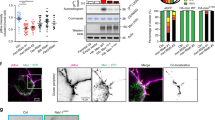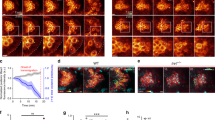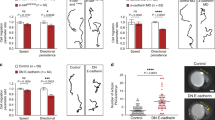Abstract
The migration of border cells during Drosophila melanogaster oogenesis is a simple and powerful system for studying invasive cell migration in vivo. Border cells are somatic cells that delaminate from the follicular epithelium of an egg chamber and invade the germ line cluster. They migrate between the nurse cells to reach the oocyte1,2, using DE-cadherin for adhesion to the substratum3. Border cells take approximately 6 h to migrate a distance of 100 μm4. The migration is guided by EGFR (epidermal growth factor receptor) and PVR (platelet-derived growth factor (PDGF)/vascular endothelial growth factor (VEGF) receptor)5,6. Here, we show that a single long cellular extension (LCE), several cell diameters in length, is formed at the initiation of migration. The LCE may function as a 'pathfinder' in response to guidance cues. LCE growth requires directional guidance signals and specific adhesion to the substratum. Interference with actin–myosin interactions allows continued LCE growth while preventing translocation of the cell bodies. We discuss similarities between LCEs and axons and the use of LCE-like structures as a general mechanism for initiating invasive migration in vivo.
This is a preview of subscription content, access via your institution
Access options
Subscribe to this journal
Receive 12 print issues and online access
$209.00 per year
only $17.42 per issue
Buy this article
- Purchase on Springer Link
- Instant access to full article PDF
Prices may be subject to local taxes which are calculated during checkout



Similar content being viewed by others
References
King, R. C. Ovarian Development in Drosophila melanogaster (Academic Press, New York, 1970).
Montell, D. J., Rørth, P. & Spradling, A. C. Cell 71, 51–62 (1992).
Niewiadomska, P., Godt, D. & Tepass, U. J. Cell Biol. 144, 533–547 (1999).
Spradling, A. in The Development of Drosophila melanogaster 1–70 (Cold Spring Harbor Laboratory Press, NY, 1993).
Duchek, P., Somogyi, K., Jékely, G., Beccari, S. & Rørth, P. Cell 107, 17–26 (2001).
Duchek, P. & Rørth, P. Science 291, 131–133 (2001).
Verkhusha, V. V., Tsukita, S. & Oda, H. FEBS Lett. 445, 395–401 (1999).
Loureiro, J. J. et al. Dev. Biol. 235, 33–44 (2001).
Parent, C. A. & Devreotes, P. N. Science 284, 765–770 (1999).
Firtel, R. A. & Chung, C. Y. BioEssays 22, 603–615 (2000).
Funamoto, S., Meili, R., Lee, S., Parry, L. & Firtel, R. A. Cell 109, 611–623 (2002).
Iijima, M. & Devreotes, P. Cell 109, 599–610 (2002).
Westphal, M. et al. Curr. Biol. 7, 176–183 (1997).
Aizawa, H., Sameshima, M. & Yahara, I. Cell Struct. Funct. 22, 335–345 (1997).
Edwards, K. A. & Kiehart, D. P. Development 122, 1499–1511 (1996).
Rørth, P., Szabo, K. & Texido, G. Mol. Cell 6, 23–30 (2000).
Knight, B. et al. Curr. Biol. 10, 576–585 (2000).
Kulesa, P., Bronner-Fraser, M. & Fraser, S. Development 127, 2843–2852 (2000).
Koster, R. W. & Fraser, S. E. Curr. Biol. 11, 1858–1863 (2001).
Yee, K. T., Simon, H. H., Tessier-Lavigne, M. & O'Leary, D. M. Neuron 24, 607–22. (1999).
Rørth, P. et al. Development 125, 1049–1057 (1998).
Wimmer, E. A., Cohen, S. M., Jackle, H. & Desplan, C. Development 124, 1509–1517 (1997).
Bunch, T. A., Grinblat, Y. & Goldstein, L. S. B. Nucleic Acids Res. 16, 1043–1061 (1988).
Lee, T. & Luo, L. Neuron 22, 451–461 (1999).
O'Keefe, L. et al. Development 124, 4837–4845 (1997).
Leevers, S. J., Weinkove, D., MacDougall, L. K., Hafen, E. & Waterfield, M. D. EMBO J. 15, 6584–6594 (1996).
Oda, H., Uemura, T., Harada, Y., Iwai, Y. & Takeichi, M. Dev. Biol. 165, 716–726 (1994).
Clark, I. E., Jan, L. Y. & Jan, Y. N. Development 124, 461–470 (1997).
Britton, J. S., Lockwood, W. K., Li, L., Cohen, S. M. & Edgar, B. A. Dev. Cell 2, 239–249 (2002).
Acknowledgements
We are grateful to C. Wilson, A. González-Reyes, Y.N. Jan, S. Leevers, W. Lockwood and the Bloomington stock center for flies, to A.-M. Voie for embryo injections and to S. Cohen for comments on the manuscript. T.A.F. was supported by a pre-doctoral fellowship from Louis-Jeantet foundation.
Author information
Authors and Affiliations
Corresponding author
Ethics declarations
Competing interests
The authors declare no competing financial interests.
Supplementary information
Supplementary figure
Figure S1. PI3K and PTEN do not affect LCEs and border cell migration. (PDF 462 kb)
Rights and permissions
About this article
Cite this article
Fulga, T., Rørth, P. Invasive cell migration is initiated by guided growth of long cellular extensions. Nat Cell Biol 4, 715–719 (2002). https://doi.org/10.1038/ncb848
Received:
Revised:
Accepted:
Published:
Issue Date:
DOI: https://doi.org/10.1038/ncb848
This article is cited by
-
Two Rac1 pools integrate the direction and coordination of collective cell migration
Nature Communications (2022)
-
The front and rear of collective cell migration
Nature Reviews Molecular Cell Biology (2016)
-
Group choreography: mechanisms orchestrating the collective movement of border cells
Nature Reviews Molecular Cell Biology (2012)
-
Reelin, Rap1 and N-cadherin orient the migration of multipolar neurons in the developing neocortex
Nature Neuroscience (2011)
-
Evolution of the VEGF-Regulated Vascular Network from a Neural Guidance System
Molecular Neurobiology (2011)



